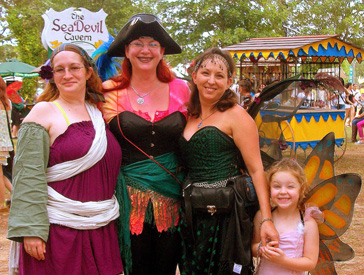
For many people, Renaissance faires are objects of bemused curiosity. Progressives and leftists in particular often wonder what exactly motivates “Rennies” – as many faire participants and workers refer to themselves – to celebrate feudal society. Aren’t these people just running away from modern problems in favor of a re-imagined past?
Well Met, Rachel Lee Rubin’s book on Renaissance faires and American counterculture, may not be enough to get you to the faire, but it clearly outlines their radical history while also showing how faires continue to provide space for working people to enjoy working class traditions from all over the world.
The first Renaissance fairee took place in 1963 in Southern California after Phyllis Patterson, a theater teacher at a children’s center in the Los Angeles neighborhood of Laurel Canyon, pitched the idea of an open-air art festival modeled on those of medieval Europe as a fundraiser for the independent and pacifist minded Pacifica Radio (now perhaps best known for hosting Amy Goodman’s Democracy Now! radio broadcast).
Calling on the local community to help get the first faire off the ground, she tapped into a huge reservoir of creative talent among Laurel Canyon residents. In fact, because Laurel Canyon was home to many former movie industry workers who were blacklisted by the House Un-American Activities Committee, Patterson found herself a community eager to create a new, non-commercial venue for craft arts and performance.
The faire was an immediate success and faires soon began popping up elsewhere in part because of their reputation of subversion. As Rubin makes clear, the faires’ open atmosphere continues to be one of its biggest attractions. Even now, despite many faires being “Disneyfied” by corporate minders who bought and consolidated small local faires during the 1990s, the faire is still known as “a place to be out” among many diverse groups – including the GBLTQ community and various political enthusiasts. Because of this, Rubin spends a majority of the time in Well Met addressing the faires as a space for play and experimentation for its workers and patrons.
Perhaps the most interesting idea in Rubin’s book is that faires have consistently provided a place for a mostly working-class audience to celebrate working-class and peasant culture from all around the world. In fact, faires have played an important role in reviving interest in home crafting traditions (including glass-blowing, leatherworking, and wheat-weaving) as well as many genres of music and theater from around the world, including klezmer music and vaudeville.
I would only offer one caveat to potential readers: this is not a popular history but a book written by an academic for an academic press. Because of this, Well Met is primarily recommended for those with a strong interest to the faires, faire history and American counterculture.
Book information:
Well Met: Renaissance Fairees and the American Counterculture
by Rachel Lee Rubin
New York University Press, 2012, 346 pages
Photo: Faire History blogspot










